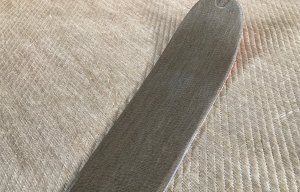
Hexcel launches HexPly Nature
Discussion ranged from the specific role of microscopic bioscaffolds in medical surgery, to the the needs of the global fibres industry.

15th May 2024
Innovation in Textiles
|
Webinar
The major importance of biosourced materials to the sustainable future of the global textile industry was the subject of an illuminating recent Innovator Xchange webinar that can now be viewed on ITMAconnect.com
Chaired by Professor Parik Goswami of University of Huddersfield in the UK, the discussion ranged from the specific role of microscopic bioscaffolds in medical surgery, to the wider potential of wool’s unique properties, and on to the needs of a global fibres industry which will expand from the consumption of 120 million tons in 2023 to 140 million tons by 2030 – and will almost certainly continue to depend to a large part on oil-based synthetics for the foreseeable future.
Medieval origins
Specifically in the medical sector, Dr Holly Morris, currently a hand and wrist surgeon at Auckland Regional Centre for Plastic, Reconstructive and Hand Surgery and also very active in researching sustainable materials in the hospital environment, observed that biomaterials have been used in healthcare applications for centuries.
“In medieval times people used spider webs in wound dressings for their antimicrobial properties and silk was employed for sutures in early surgeries,” she said. “Biomaterials are also to be found in pharmaceuticals – aspirin for example is derived from willow bark – and then there is the whole world of herbs and potions used in traditional Eastern medicine.
“In modern day medicines we’ve refined what has been traditionally used, but the range is huge – everything from wound dressings that benefit from Minuka Honey’s antimicrobial properties to things such as alginates through to the bio-scaffolds which we use for cell regeneration, where we might be using recombinant spider silk, collagen or chitosan. It’s about harnessing what nature can already do and applying it to human health.”
Carbon footprint
Healthcare, she added, is a huge generator of textile waste and disposable products account for around a third of overall carbon footprint.
A major problem for waste collection in hospitals, however, is that the safety of patients is always paramount. As a result many single-use textiles and nonwovens that are employed in surgeries are simply being classed as hazardous to avoid any doubt. There is also not the time in such a high-pressure environment for the advanced sorting of used materials.
“It’s not just the larger textiles such as surgical gowns and drapes, but also dressings and reusable orthotics and there’s a big potential for innovation through better understanding materials,” Dr Morris stressed. “We still can’t grow bone or cartilage adequately on scaffolds from silk or collagen to the point where we can implant them, for example, so there’s huge scope for amazing work that can have an impact.”
SUPD
Moving to the macro, Adrian Wilson, editor of Innovation in Textiles, said that there were huge markets for single use absorbent products such as baby diapers that are at present 90% based on synthetic fibres such as polypropylene.
“Certain absorbent disposables have already faced action from the European Union with the 2021 Single Use Plastics Directive (SUPD),” he said. “This required baby wipes and femcare items to be plastic-free or face penalties, which the industry said was impossible, but interestingly they all managed it. So the SUPD illustrates what can be done with legislation.”
Huge progress is being made in many areas, he added, with one very promising development being additives for polyester and other synthetics that enable them to break down and biodegrade just like natural fibres.
“This is something that’s hugely practical and can be enacted on a large scale very quickly,” Wilson said. “We need big, practical solutions, and we need them quicker than the legislation can respond to get them there. You can’t build the plants that we’ve got out there again, it simply won’t work.”
Magic material
The discussion then turned to the specific properties of wool, which Professor Goswami referred to as “the magic material and a cocktail of fascinating different amino acids”, and Rebecca Kelley, European Product Marketing Manager for The Woolmark Company described as “incredibly diverse”.
“There are over a thousand sheep breeds globally each producing different types of wool in terms of properties such as fibre diameter, length, crimp and colour,” she said. “It’s one of nature’s most innovative fibres and designed to keep animals protected in diverse environmental conditions.”
The nonwovens sector is of particular interest too wool researchers, she added, with startups like Australia’s Woolchemie working with CSIRO in Australia to use lower value, coarser wool to replace synthetics in items like baby diapers.
Questions
The webinar attracted an unprecedented number of questions and observations from a global audience and many concerned the potential for scalability and financial viability of biosoured materials in the coming decade.
It was observed that in 2022, around 1.8 million tons of bioplastics were produced overall, with much of this volume going into packaging rather than fibres, compared to over 400 million tons of conventional oil-based plastics and synthetic fibres, suggesting a considerable mountain to climb.
Bio-based drop-in solutions were said to have great potential, enabling the replacement of a portion of synthetics in existing manufacturing processes, such as biosourced MEG monomers as 30% of polyester. They can, however, cloud the picture, especially in light of the European Union’s latest initiatives to prevent greenwashing.
PLA and PHA were further identified as growing new fibres, while still being classed as plastics by the EU.
Life savers
Wilson remarked that in the single month of November 2020, no less than 127 billion facemasks were consumed globally.
“This was in response to Covid-19, the biggest threat we’ve faced in many decades,” he said. “They were all based on synthetic fibres and it would have been great if they could have been biobased instead, but they saved a lot of lives.”
“The medical profession was horrified by the Covid-19 footprint and all the disposables and in hindsight, clever design could have removed a lot of the plastics from the beginning,” Dr Morris added. “The benefit of reusables, certainly for items like gown and drapes which can be based on natural or biofibres, is that you automatically enhance supply chain resiliency, which was one of the major problems we had during Covid and the shortages of PPE.”
Collaboration
The panellists agreed that given the multifaceted nature of biosourced materials, interdisciplinary collaboration between scientific fields such as biology, chemistry and materials science would be vital in further unlocking novel applications and functionalities and driving the industry forward.
“Industry-wide collaboration is certainly the key to progress for all biosourced materials,” Professor Goswami concluded.
The webinar can be accesed here.

Business intelligence for the fibre, textiles and apparel industries: technologies, innovations, markets, investments, trade policy, sourcing, strategy...
Find out more